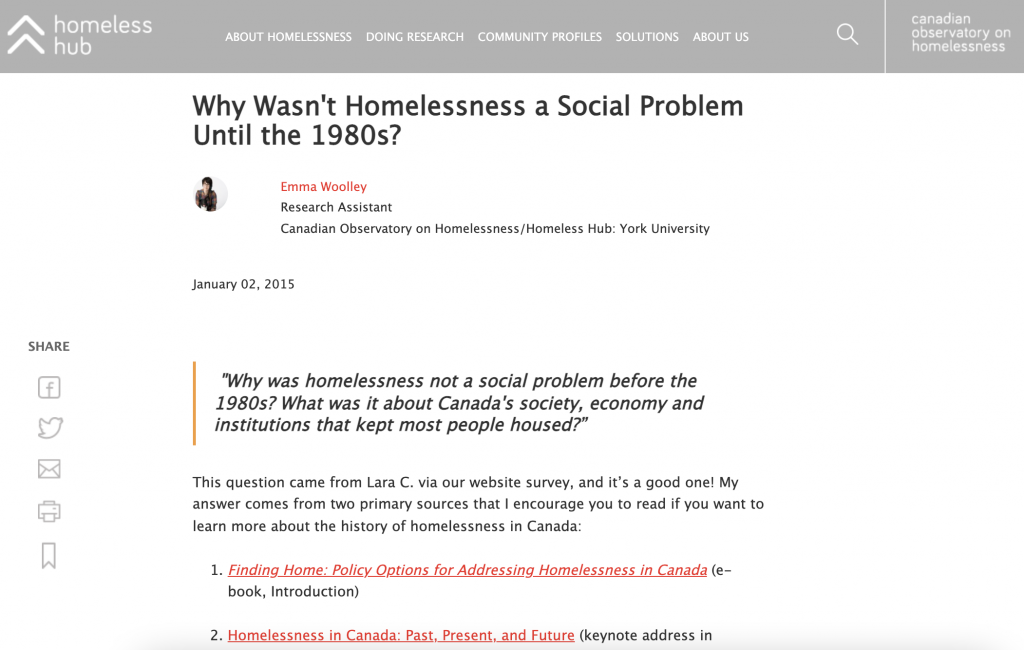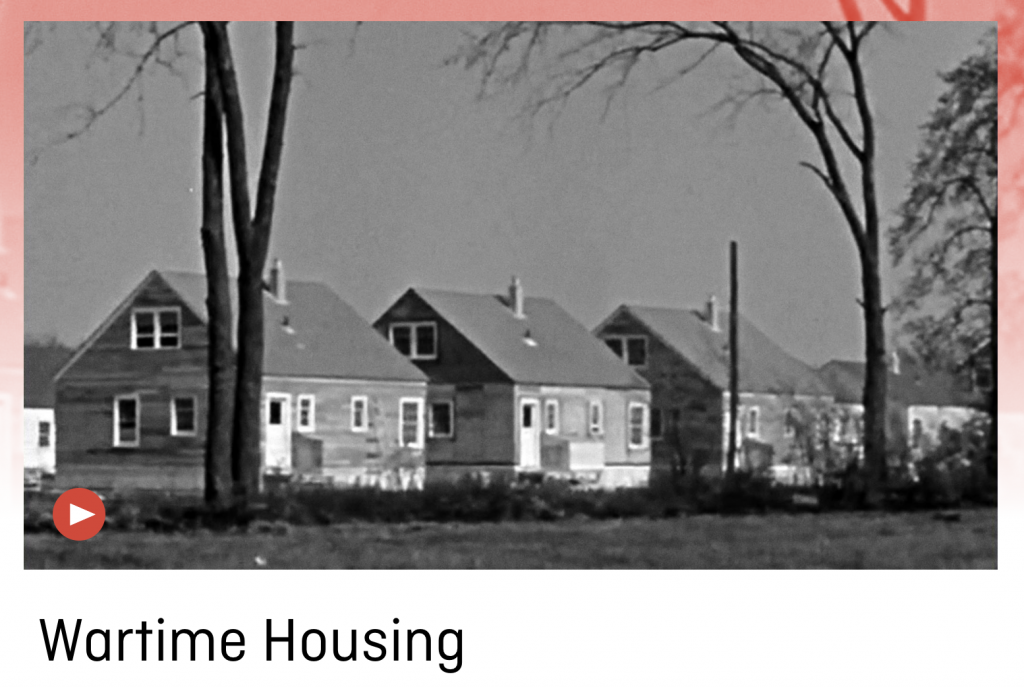1. What housing policy existed in the past?
What is the housing market like in the community where you live? You can check out your neighbourhood and others in the Canadian Mortgage and Housing Corporation’s Housing Market Information Portal. Go ahead – we’ll wait!
Across Canada housing prices are on the rise. Analysis of housing policy trends throughout Canada’s history show that the solutions the government adopts to meet the problems deemed essential at one point in time have often created a new set of problems that require different solutions in the period that follows (Carroll, 1989). Essentially this suggests that much of our housing policy is created as a reaction to the policy choices that came before. In this section, we explore the question of what housing policy existed in the past, as a way to set the stage for understanding what housing policy decisions are being made today.
Before you begin this section, we encourage you to take a moment to reflect on what you already know about historical housing policies in Canada. Whether you are familiar with this issue already, or whether this is your first introduction to the topic, it is beneficial to consider what you know before moving forward. You may wish to write a brief summary of your knowledge or some questions you have at this time. This writing is for your benefit only and not going to be shared with your instructor or fellow classmates. You should feel free to write as little or as much as you wish to help you identify your starting point before moving into the material.
How to complete this activity and save your work: Type your response to the question in the box below. When you are done answering the question navigate to the ‘Export’ page to download and save your response. If you prefer to work in a Word document offline you can skip right to the Export section and download a Word document with this question there.
You may find it interesting to know that homelessness did not exist, in its current form, before the 1980s in Canada. Although there were hobos who would ride the rails in search of employment in the early 1900s, we did not have the crisis situation that we have today. We begin this section with an exploration of the idea that mass homelessness is a modern occurrence, through a video of Dr. Bill O’Grady and a blog post from the Homeless Hub.
 When the videos in this ebook are almost done playing, the message “Stop the video now” will appear in the top left corner. This is a reminder for those who have turned on the Autoplay setting to manually pause the video when the speakers are done to avoid having it autoplay through to the next video. This message will appear in all researcher videos throughout the ebook.
When the videos in this ebook are almost done playing, the message “Stop the video now” will appear in the top left corner. This is a reminder for those who have turned on the Autoplay setting to manually pause the video when the speakers are done to avoid having it autoplay through to the next video. This message will appear in all researcher videos throughout the ebook.
Note: Viewers may still need to use their discretion in stopping other YouTube content such as ads.
Dr. Bill O’Grady: Homelessness in the past compared to today
In this video Dr. William [Bill] O’Grady draws our attention to the way ‘homelessness’ is a word that is used much more commonly today than it was prior to the 1980s. He notes that while poverty and homelessness existed, there were governmental supports in place to assist people. Dr. O’Grady encourages us to ask hard questions about why the problem of homelessness has emerged over the last 30-40 years and notes we will only find the answers by looking at larger structural changes that have taken place in the Canadian economy and polity from the 1980s onwards. This video is 1:19 in length and has closed captions available in English.
Key Takeaways – Dr. Bill O’Grady: Homelessness in the past compared to today
- Homelessness was not a word that was used much prior to the 1980s. There was poverty and homelessness, but not to the same degree as we see today.
- Today in Canada the same housing stock that supported people prior to the 1980s does no longer exist.
- It is important that we ask ourselves, why has that happened? Why has the problem emerged over the last 30 or 40 years?
- To get the answer, we need to look at larger structural changes that have taken place in the Canadian economy and polity since the 1980s and onwards.
- We need to improve to the point where people have dignity, a place to live, and a decent life to look forward to.
Click the image below to open a new window and read the full blog post, “Why Wasn’t Homelessness a Social Problem Until the 1980s?” by Emma Woolley.
 Urban restructuring throughout Canadian cities in the 1980s and 1990s meant that society underwent political, economic, and spatial shifts in how people interacted, what kinds of jobs they had, where they lived, and what kinds of supports were available from the government (Greene, 2014). These shifts were polarizing, in that they produced and consolidated new forms of social and spatial segregation, which became evident with the emergence of mass homelessness around this time (Greene, 2014).
Urban restructuring throughout Canadian cities in the 1980s and 1990s meant that society underwent political, economic, and spatial shifts in how people interacted, what kinds of jobs they had, where they lived, and what kinds of supports were available from the government (Greene, 2014). These shifts were polarizing, in that they produced and consolidated new forms of social and spatial segregation, which became evident with the emergence of mass homelessness around this time (Greene, 2014).
Knowing that mass homelessness emerged in the 1980s and 1990s raises the question of “why?” It was not the case that a large number of people suddenly became homeless for no reason. Rather, this was the foreseeable result of policy decisions made by the Federal government at the time. To understand what happened, we need to set our sights even further back in history to the World War II era. Dr. Nick Falvo takes us through the history.
Dr. Nick Falvo: What housing policy existed in the past?
In this video Dr. Nick Falvo speaks about the history of social housing in Canada. Although there was virtually no government assisted housing prior to the second World War in Canada, this time period saw the development of wartime housing. Dr. Falvo explains that this development was jointly driven by the need to house civilians engaged in the war effort making munitions and supplies to send overseas, and the advocacy of soldiers in need of housing upon their return from war. The 1960s and 1970s saw the birth of Canada’s social welfare system and strong support for social housing from high orders of government. In the 1990s policy shifted toward neoliberal declines in social spending. This represented a time period which Dr. Falvo describes as being “very dark years of housing policy in Canada.” This video is 4:09 in length and has closed captions available in English.
Key Takeaways – Dr. Nick Falvo: What housing policy existed in the past?
- Before World War 2 there was virtually no government assisted housing. If you were low-income and could not afford housing, you were largely dependent on your family or church for assistance.
- During World War 2 we saw an increase in government assisted housing for a few reasons.
- A lot of civilians were engaged in the war effort and needed government assisted housing in order to work in key industries, such as making munitions and supplies for soldiers overseas. Workers had to be physically present to participate in the war effort, so the government created wartime housing. They are small, cheaply made cottages with limited rooms; they still exist today.
- When soldiers returned from the war they were not immediately given housing, but had to fight for it. After advocating for their needs, they were given wartime housing as well.
- The 1960s began the birth of Canadian social policy and social housing policy, with the creation of Canada’s social welfare system. In the area of 20,000 – 30,000 units of social housing were built every year in the 1960s and 1970s in Canada, and there existed long-term funding agreements from senior orders of government and strong political support.
- In the 1990s neoliberal policies emerged that resulted in very dark years of housing policy in Canada. There was a high-level government reluctance to spend money and social housing lost its support. Since the early 2000s this has gradually begun to shift back towards social housing support again.
Wartime housing was created for people working in the war-industry, but soldiers had to advocate for themselves to get access to housing upon their return. Consider this brief Heritage Moment clip entitled, “Home from the Wars.”
Canada’s current housing crisis stems from decades of policy decisions, not only about housing but about social welfare supports as well. Dr. Jonathan Greene further explains the timeline of these policy changes, beginning during the second World War when government housing was provided to citizens, not because it was the right thing to do but because it helped the economy.
Dr. Jonathan Greene: What housing policy existed in the past?
In this video Dr. Jonathan Greene provides a comprehensive overview of key dates and pieces of legislation in Canada’s social housing policy history. He argues that the consistent bias throughout this history is to allow the market to be pre-eminent in providing housing for Canadians and for the government or public authorities only to intervene to pick up the pieces. Dr. Greene traces the history of social housing, beginning before the second World War, when there was very limited federal or provincial housing interventions. In the early 1940s there was a wartime housing program developed, and the National Housing Act amendments represented a more forceful intervention by the federal government into creating social housing. It is noteworthy that this housing was intended to be short-term and was built to support job development and the economy, as civilians moved to cities to work in the war effort, leading to housing shortages. Dr. Greene further traces the development of social housing in the 1960s, the entry of third-party sectors into building social housing and co-operative housing in the 1970s, the beginning of the federal withdrawal in the 1980s, and the culmination in 1993 when the federal government moved out of creating social housing completely. This video is 6:11 in length and has closed captions available in English.
Key Takeaways – Dr. Jonathan Greene: What housing policy existed in the past?
- There is a consistent bias in housing policy in Canada, including with the social housing sector, to allow the market to be pre-eminent in providing housing for Canadians and for the government or public authorities only to intervene to pick up the pieces.
- Even when we have sought to provide housing for lower income groups, or to create affordable housing, we often do it by subsidizing private market developers.
- There have been moments in time when the government has become more active in creating socially owned and operated units geared towards lower-income people, which were quite important in our history, but it has always been with the bias towards the market.
- Before World War 2 there were not many federal or provincial housing interventions.
- The Dominion Housing Act was created in 1935 but was not that substantial.
- The National Housing Act was created in 1938 to try and subsidize the creation of private homeownership units by providing mortgage assistance.
- In the 1946 we saw the federal government begin to intervene in ‘public housing’ more forcefully by creating affordable housing.
- In the early 1940s there was the wartime housing program that provided several thousand units of housing for people who came to work in the war effort.
- As people moved to the cities to help with the war effort, it created a massive housing problem, so the federal government intervened.
- A lot of the housing that was built was meant to be temporary housing, because again (due to the bias towards letting the market operate), the government did not want to intervene too long.
- Creating housing at this time was also done to allow people to work and help the economy, as opposed to creating affordable housing for the benefit of citizens and helping people in need.
- In the 1960s we begin to see the federal government make a strong effort to intervene in creating social housing, using the National Housing Act to take the lead.
- Some provinces and cities were active, as of the late 1940s – 1950s, in providing some funding for social housing. For example, Ontario had a lot of that in relation to other provinces. This expectation that cities would assist financially happened a lot through the 1960s period particularly.
- In 1973 National Housing Act amendments establish the not-for-profit sector / social housing.
- The government recognized the quality of the housing they were building was not adequate, and discussions about ‘slum housing’ began.
- The 1973 NHA amendments brought in third sector partners to create co-operative housing and social housing with programs mixed in.
- A lot of the social housing at that time was about income mixing, with non-profit housing providers creating low-income suites but also brining in marker renters to help subsidize the project.
- Co-operative housing, like the St. Lawrence Market District in Toronto, are where people actually begin to own the housing cooperatively.
- Beginning in the 1980s the federal government begins a lot of cutbacks to social housing, then moves entirely out of creating new affordable social housing, public housing in 1993.
Federal housing and social policies have undergone many changes since the World War II period. As you watch this brief 17–minute documentary entitled, “Wartime Housing” created by the National Film Board of Canada, it is beneficial to keep in mind that new policies are often created as a reaction to problems that were created by previous policies. What problems do you think followed the post-World War II era in Canada?
Click the image below to open a new window and watch the “Wartime Housing” documentary.
What do you think?

Wartime housing was built throughout Canada for people working in war-related industries, and later for soldiers. Have you noticed any of these houses in your own neighbourhood? The next time you are out for a walk or a drive, take a look around and see if you can find anywhere you live.
Following the Second World War period, that saw strong Federal investments in social housing, a shift began to occur in the 1980s. A recession at the time meant that the government started to decrease their investments in social housing in the 1980s and stopped building it entirely in the 1990s, making it instead the responsibility of Provincial governments. In Ontario, the provincial government further downloaded the responsibility for social housing to municipalities. In the next set of videos Dr. John Ecker, Dr. Erin Dej, and Dr. Jacqueline Kennelly explain this history of policy changes.
Dr. John Ecker: What housing policy existed in the past?
In this video, Dr. John Ecker highlights the shifts in affordable housing legislation that have occurred in Canada since the post-World War II period. In 1938 the federal government passed the National Housing Act, which made provision for construction of low rent housing, and in 1949 it was expanded to include funding for publicly owned and provincially managed housing for low-income families, seniors, and people with disabilities. Dr. Ecker notes that we see this legislative support withdrawn in the early 1990s, followed by an announcement in 1996 that the management and ongoing subsidies would be transferred to the provinces. This video is 1:40 in length and has closed captions available in English.
Key Takeaways – Dr. John Ecker: What housing policy existed in the past?
- In the post-World War 2 period there was an acknowledgement from the federal government that people were returning from war and needed affordable housing.
- The National Housing Act was the first federal social housing legislation. It was introduced in 1938 and made provision for construction of low rent housing.
- In 1949 the Nation Housing Act included funding for publicly owned and provincially managed housing for low-income families, seniors, and people with disabilities.
- In 1993 the federal government withdrew funding for new social housing, and in 1996 they announced that the management and ongoing subsidies of existing social housing would be transferred to the provinces.
Dr. Erin Dej: What housing policy existed in the past?
In this video Dr. Erin Dej discusses the shifts in federal investments for social housing that have occurred over the past several decades in Canada. In the 1950s and 1960s there were strong post-war investments in building social housing, that continued up until the 1980s. Beginning in the 1980s the federal government began to withdraw from their role in building social housing, and in the 1990s formally stepped back from creating new social housing and also from maintaining the social housing stock that already existed. This video is 2:56 in length and has closed captions available in English.
Key Takeaways – Dr. Erin Dej: What housing policy existed in the past?
- In the 1950s and 1960s there were federal investments in social housing for soldiers returning from war.
- Homelessness at this time was almost exclusively experienced by adult men who were moving from city to city looking for work.
- From the 1950s – 1980s we had huge investments in social housing, such as by building 20,000 social housing units a year every year.
- In the 1980s the federal government started to decrease their investments in building affordable housing, and in 1993 they officially took a step back.
- At the same time there were cuts to social assistance, such as welfare programming in the 1990s, with no new investments in social housing.
- In addition to not building new social housing, there was not investment in repairing existing social housing. This meant what existed previously fell into disrepair and could no longer be used.
Dr. Jacqueline Kennelly: Historical downloading of affordable housing
In this video, Dr. Jacqueline Kennelly discusses the impact of wealth inequality as a risk factor for homelessness. She traces the roots of current poverty and homelessness to federal policy decisions made in the 1990s to withdraw from creating affordable housing, and to download the responsibility to provinces which had varied responses, such as further downloading to municipalities with limited tax bases. This video is 1:38 in length and has closed captions available in English.
Key Takeaways – Dr. Jacqueline Kennelly: Historical downloading of affordable housing
- While there is truth that anyone can become homeless, we also need to recognize that wealth inequality means some people are at much greater risk than others, based on low having low-income support.
- In the 1990s the federal government’s decision to stop creating affordable housing, and to download it to provinces, resulted in varied responses.
- Ontario, for instance, further downloaded responsibility for affordable housing to municipalities, which had to rely on their property tax bases to fund development of new affordable housing.
- Additional governmental policies and choices over time, such as keeping minimum wage and welfare rates low, have resulted in impoverishment, wealth inequity, and homelessness in Canada.
Housing policy decisions made in the past have brought us to where we are today in Canada. Much of our understanding about housing policy comes from the work of Professor David Hulchanski, whose influential research is widely cited. At this time, we encourage you to read some of his co-authored work entitled, “Canada’s Housing Story.”
Featured Reading:

Chisholm, S., & Hulchanski, D. (2019). Canada’s housing story. In D. Maclennan, H. Pawson, K. Gibb, S. Chisholm, & D. Hulchanski (Eds.). SF 21: Shaping Futures Changing the Housing Story Final Report. University of Glasgow: Policy Scotland.
The lack of affordable housing today is a problem that contributes to high rates of homelessness across the country. However, we also must consider that housing is one piece of a complicated and interconnected puzzle that also requires we address poverty and the lack of financial supports in our current neoliberal state structure. Preventing and ending homelessness requires strategic investment and changes to policies and practices to address the risk factors that contribute to homelessness (Dej & Ecker, 2018). Until the underlying structural and system pieces that contribute to homelessness are addressed, we are going to continue to see high rates (Gaetz, 2010). In these next two videos, Dr. Tim Aubry and Dr. Stephen Gaetz explain how poverty, a lack of affordable housing, and neoliberal state governance are related factors that have carried forward over time.
Dr. Tim Aubry: What housing and homelessness policy existed in the past?
In this video, Dr. Tim Aubry discusses three macro level policy issues that have driven increased rates of homelessness in Canada. First, beginning in the 1980s and 1990s the Federal government’s decision to withdraw from building social housing has led to a lack of affordable housing in cities across Canada. Second, homelessness needs to be recognized as the face of extreme poverty in Canada, that persists despite some poverty-reduction measures such as the Canada Child Benefit that have had limited impact. Finally, Dr. Aubry argues we must examine additional social policies and institutions that have contributed to homelessness, such as the child welfare and mental health systems. This video is 5:20 in length and has closed captions available in English.
Key Takeaways – Dr. Tim Aubry: What housing and homelessness policy existed in the past?
- At a macro policy level, a major driver of rising homelessness in the past 30 years has been the stoppage of creating affordable housing, and particularly social housing, by the federal government.
- In the 1980s and 1990s we let the social housing market flounder and stopped building, perhaps with the expectation that the private sector would take up the building and there would be low-cost rentals.
- It is well recognized that the first thing that needs to be done to get people out of homelessness and prevent homelessness from further growing is to create more affordable housing, particularly in cities across Canada.
- Homelessness is the face of poverty – extreme poverty – in our country.
- A range of people experience homelessness, including men, women, young people, families, etc. What they have in common is that they are economically poor. For instance, someone who loses their housing but has money will be able to get housed again quickly, whereas someone without the same access to funds will find themselves falling into homelessness.
- Poverty is a growing problem. There have been some policy interventions for families, such as through the Canadian Child Benefit, but these interventions have had little impact in the overall numbers of people living in poverty.
- Additional social policies and institutions need to be considered as well.
- Many young people experiencing homelessness have had involvement with the child welfare system.
- The mental health system in Canada has evolved over time, where psychiatric institutions have been closed but we have not put in place the kind of supports that people need to build a life in the community, while living with severe and persistent mental illness.
Dr. Stephen Gaetz: What housing policy existed in the past?
In this video, Dr. Stephen Gaetz argues that we created modern mass homelessness in Canada through a number of policy decisions, a changing economy, and the rise and application of neoliberalism. Beginning in the late 1980s, the federal government shifted from making direct investments in building affordable housing to using market measures, such as tax expenditures, to encourage private sector building and new homeownership. After 30 years of not investing in affordable housing for low-income people, combined with a population increase of 30%, we have created the housing crisis we are living in today. Dr. Gaetz further recognizes the impact of neoliberal cuts to income supports, and a changing economy that promotes part-time and low-paying jobs, as key drivers that have led to a dramatic increase of homelessness in Canada. This video is 3:22 in length and has closed captions available in English.
Key Takeaways – Dr. Stephen Gaetz: What housing policy existed in the past?
- The emergence of modern mass homelessness is well understood.
- We created modern mass homelessness through a number of policy decisions, through a changing and evolving economy, and through the rise and application of neoliberalism.
- In the post-war period Canada had a steady investment in building affordable housing, up to 20,000 units annually up until the late 1980s.
- A neoliberal turn in the late 1980s meant the government shifted from direct investment in building affordable housing to using market measures, such as tax expenditures to encourage the private sector to build housing and to encourage people to become homeowners.
- This led to a major dive in federal investment in building affordable housing. It was an experiment – will this investment and inspiring individuals to buy houses and the private sector to build houses, will that solve the problem?
- The results are in – it did not work. The housing that was built were primarily detached family homes and condominiums. The private sector investment in building rental housing went from about a 1/3 of all housing to almost 10% in 10 years.
- This created the housing crisis we are living in today.
- After 30 years of not investing in building affordable housing for low-income people, combined with a population growth of 30%, we have a housing crisis.
- The housing crisis is a big part, but not the only part of mass modern homelessness. There has also been a neoliberal trend of rolling back state investments in income supports, such as welfare cuts in the 1990s, and global and economic shifts, such as loss of industrial jobs, and the rise of part-time, low paying work.
- The housing crisis, combined with economic shifts have meant many more people are not only vulnerable to homelessness but are becoming homeless.
In this section, we considered the question, “What housing policy existed in the past?” The answer is important to know because, as we have seen, policy decisions tend to be made in response to problems created by previous policy decisions. We began our timeline around the second World War, when housing was built for people working in the war industry and for soldiers after they advocated for their needs. We saw that Canada had a strong network of social supports in the 1960s and 1970s, but that they declined with the recession of the 1980s. During this period, the federal government began to withdraw from building social housing and subsequently withdrew completely in the 1990s. These neoliberal policy decisions created conditions of extreme poverty and wealth inequality that persist. Although we may not have heard much about homelessness prior to the 1980s, we certainly feel its presence today.
Podcast: What housing policy existed in the past? (27:54)
Click the link below to listen to all of the researchers answer the question “What housing policy existed in the past?” in audio format on our podcast!



